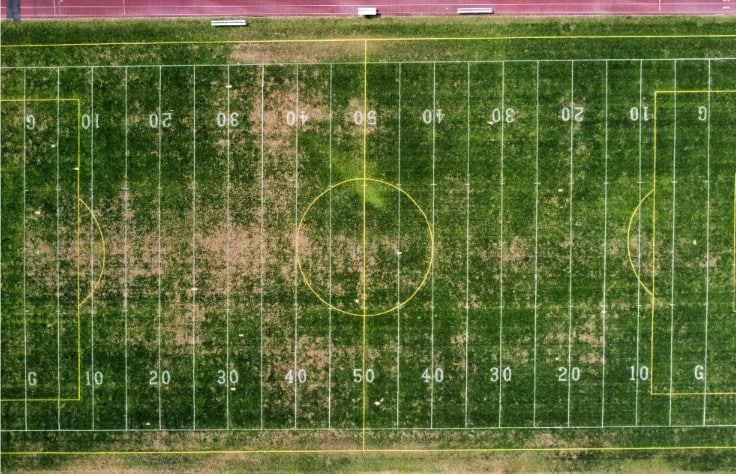An aerial view of the current Longmeadow High School stadium.
Photo credit: Town of Longmeadow MA’s YouTube channel
LONGMEADOW — The town of Longmeadow is weighing how it wants to restore the stadium at the high school after studies found that the current grass field is basically unusable at this point.
During a public meeting at the Longmeadow Adult Center on April 3, representatives from Tom Irwin Advisors presented a feasibility study that illustrated many of the problems at Lancer Field right now, and the different routes the town can take in improving it.
The consultants were engaged by the town to create and present the study.
“Why we’re here is that there’s a problem,” said Kevin Dufour, a sustainability advisor from Tom Irwin. “And that problem is that there’s a field that’s largely unusable.”
Background
The study stemmed from a citizen’s petition article approved at the May 2024 Town Meeting, which funded a feasibility study about whether the Longmeadow High School stadium’s field should be maintained as grass or replaced with synthetic surface.
To satisfy the 2024 article’s requirement of public input and feedback, the town also launched a survey earlier this year for residents to weigh in on the town’s athletic fields and whether people want a synthetic surface at the Longmeadow High School stadium.
“Gathering public feedback is important to help guide the direction that rehabilitation, renovation or reconstruction may go,” Town Manager Lyn Simmons said at the time. “Regardless of the field being turf or natural grass, work is needed to renew the fields, track and press box. The fields and stadium were not renovated as part of the new high school in 2012.”
Simmons said the survey garnered around 700 responses.
Problems with current field
Although a formal study done by SLR International in 2023 found that half the town’s grass athletic fields needed restoration, the focus of the April 3 presentation was on improving the high school stadium.
During the process of forming the feasibility study, Tom Irwin Advisors found that the field’s consistently wet conditions and lack of a dry down period has caused many scheduling headaches for Longmeadow athletics in recent seasons.
In one instance, a game had to be rescheduled last minute because of the poor condition of the field, according to Scott Vose, a project advisor with Tom Irwin.
“[The field’s poor condition] creates a huge headache of rescheduling, trying to find a site that can host a game, and then trying to get your fans there to support your team,” Vose said. “So ideally, the greatest situation is to be able to host [games] in your hometown, in front of your hometown fans, and unfortunately that wasn’t the situation that was happening at the high school.”
Despite minimal use of the stadium last fall, the field is currently a large safety concern for players due to shallow rooted grasses that tear out easily, an unstable surface prone to divots and muddy holes, minimal run-out area and prolonged saturated conditions that are difficult to maintain.
The consultants also found many inconsistencies in the soil environment based on surface hardness testing, which showed that some areas of the field had hardness levels of sand on a beach while other areas were way too soft.
Aside from those concerns, the stadium field’s irrigation system is in disrepair, causing inconsistent water distribution on the north end of the field, and the field’s topsoil is very slow to infiltrate water, which means saturation is a constant concern.
“A field that is too soft has unsure footing, doesn’t allow cutting and rapid movements, and can lead to an injury,” Dufour said. “It also can cause fatigue injuries as well, because you’re constantly moving that material around.”
The other aspect of this is maintenance. While Tom Irwin commended the town’s staff for maintaining the athletic fields to the best of their abilities, they acknowledged that a staff shortage is making it difficult to keep everything up to par.
According to the advisors, around one to three full-time personnel are required to maintain 14 acres of athletic fields at Longmeadow High School. Right now, the town has four to five personnel along with supplemental seasonal help covering 60 acres across town.
“We can see that efforts have been made … it’s just not enough,” Dufour said. “There’s not enough labor force to pay the proper amount of attention to the athletic field, all of the athletic fields, but in particular, the stadium.”
Tom Irwin’s recommendation
With all of these issues in mind, the advisors at Tom Irwin recommended that Longmeadow install a synthetic turf surface at Lancers Stadium Field.
Dufour said that as a sustainability advisor, he is usually not a fan of recommending synthetic, but due to the current field’s dilapidated condition, he believes this is the best choice.
“Frankly, anything that you do to maintain the natural grass field is going to be fighting against the tide,” Dufour said. “The soil itself is a problem, so the field would need to be removed and basically rebuilt or heavily amended.”
According to Tom Irwin, synthetic turf has many benefits. Aside from higher durability and its ability to be rain resistant, synthetic can generally be used more frequently and for a longer season than natural grass.
It would also mitigate Longmeadow’s scheduling issues and the headaches that come with having to bus teams to other fields for major sporting events.
“The main benefit [of synthetic] for this community is scheduling,” Vose said. “To be able to host your one-seed games; that’s a huge advantage when you get to the playoffs.”
Synthetic brings many cons to the forefront, however, which is something the town will have to consider. Outside of its abrasiveness, there are also many environmental concerns that come with this type of field.
According to Tom Irwin’s presentation, synthetic turf contains layers of plastic, rubber and sand. Some turf products contain a group of chemicals known as PFAS. These chemicals have garnered the moniker “forever chemicals” because they do not break down in the environment over time.
Additionally, synthetic does not filter air or water pollutants like natural turf does and the fiber typically degrades under UV light over time.
There is also the issue of cost that the town needs to figure out. Dufour and Vose pointed out that installation of a synthetic surface would cost about $1.5 to $1.8 million with a synthetic shock pad included, which is used to keep the ground soft and safe.
Other expenses are also required though, like irrigation, annual maintenance, labor and surface recarpeting every eight to 10 years.
In its presentation, Tom Irwin said that if all this is not fiscally possible for Longmeadow, then they recommend that the town pursue a provisional option, which includes improving the stadium “via a reconstruction effort with sand channeling drainage and concentrating on improving additional fields while fundraising until a synthetic field can be installed.”
This option would improve the drainage on the field, but only to a limited extent, according to Dufour, which is partially why Tom Irwin recommends synthetic.
“When you look at the overall cost, when you look at the environmental ramifications, when you look at the challenges with maintaining a natural grass field, there is no perfect solution here,” Dufour said. “So when we looked at this from soup to nuts and kind of came down to balancing it out, I, and us as a group, came down on the side that perhaps a synthetic is the best option, given all the challenges facing this particular field that would allow the town and the student-athletes and everyone else to be able to have a service that they could play on, that they could be proud of, that could do what it is supposed to do, and that is within budget.”
Residents can watch the full feasibility study presentation on YouTube: tinyurl.com/3fn76rzb, or visit the town website to read the full feasibility report.
No decisions were made about which direction the town would go in regarding restoration of the field.



